Introduction
ASEAN plays a significant role in global geopolitics, both economically and in terms of security, as a region experiencing rapid economic growth and serving as a hub in the global supply chains in manufacturing. However, geopolitical competition between major powers—particularly the United States and China—has brought about structural changes in areas such as the economy, trade, and technology, directly affecting ASEAN. This is especially evident in the era of "Trump 2.0" under U.S. President Donald Trump, who introduced new import tariff policies starting April 9, 2025. These policies impose higher tariffs on nearly all countries worldwide, including ASEAN countries, with the aim of restructuring global trade and reducing reliance on China’s supply chains. This policy significantly complicates the economic and geopolitical dynamics in the region.
Given ASEAN's role as a geographic and economic connector between major powers, the region now faces growing challenges. This study aims to analyze ASEAN’s economy through the lens of geopolitical dynamics to assess the economic risks that ASEAN may face in the future amid pressure from U.S. tariff policies and possible retaliatory actions from China that could shift the balance of power in the region.
Geopolitical Dynamics in ASEAN
In recent years, ASEAN has become a focal point for geopolitical competition between the U.S. and China, both of which aim to expand their influence in the region across economic, military, and security aspects. In addition to these two major powers, other key players such as Japan and Russia also play specific roles in fostering cooperation with ASEAN countries. Understanding the roles of each party is crucial for assessing geopolitical impacts and preparing for emerging challenges.
China’s Influence
China plays a significant role in ASEAN in both economic and security dimensions, particularly through the BRI and the South China Sea disputes.
China has been expanding its influence in the ASEAN region through a foreign policy focused on economic cooperation and strategic security. A key component of this strategy is One Belt One Road or the Belt and Road Initiative (BRI)—a global infrastructure development plan encompassing transportation, communications, energy, and several special economic zones. China has made substantial investments in ASEAN member states, particularly in Cambodia and Lao PDR.1/
In addition, China has exerted its security influence through the South China Sea dispute, claiming sovereignty over most of the area within the so-called Nine-Dash Line (Figure 1). This has led to growing tensions with several ASEAN countries, particularly the Philippines and Vietnam2/ In recent years, there have been multiple confrontations between Chinese and Philippine vessels, prompting the Philippines to strengthen its military cooperation with the U.S. as a counterbalance to China's rising power. The South China Sea dispute also has implications for economic and trade stability, as the area serves as a vital maritime route for international trade among many ASEAN countries. The increasing involvement of the U.S. in the region has further intensified the situation.
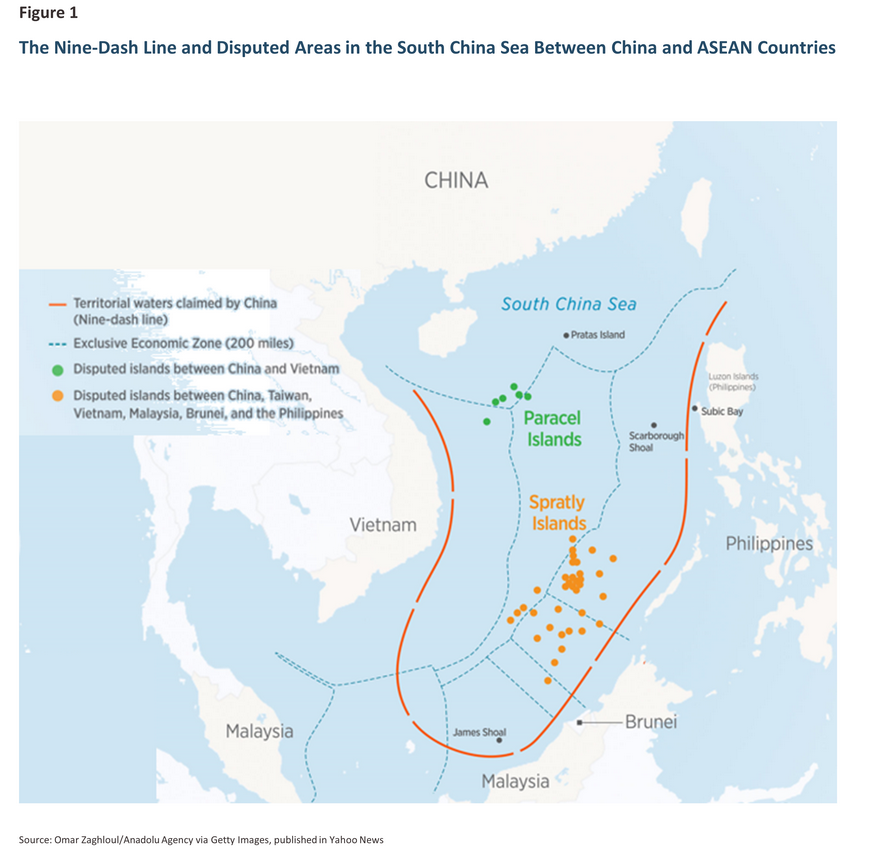
U.S. Influence
The U.S. exerts influence over ASEAN through military security cooperation, economic partnerships, and investment.
The U.S. has played a significant role in the region for a long time and currently engages in power balancing in the Indo-Pacific region through the Indo-Pacific Economic Framework for Prosperity (IPEF), which aims to strengthen security, trade, and diplomacy. The presence of U.S. military forces in the region reflects its commitment to protecting national interests and is part of efforts to prevent the expansion of China's influence in the South China Sea. Examples of cooperation include the U.S. having key military bases in Singapore and the Philippines3/ Additionally, the U.S. counters China's growing influence at the regional level by forming security alliances such as Quad and AUKUS4/
In terms of economics, the U.S. is a key player as one of the largest markets in the world, absorbing exports from ASEAN countries (Figure 2). At the same time, it plays a role in promoting trade through frameworks for cooperation in trade and investment with countries that have close relationships, such as Singapore, which serves as the center for U.S. trade and investment in the region, and Vietnam, which advanced its relationship with the U.S. in 2024 to a Comprehensive Strategic Partnership to increase investment in Vietnam and foster cooperation in areas such as technology and supply chains.
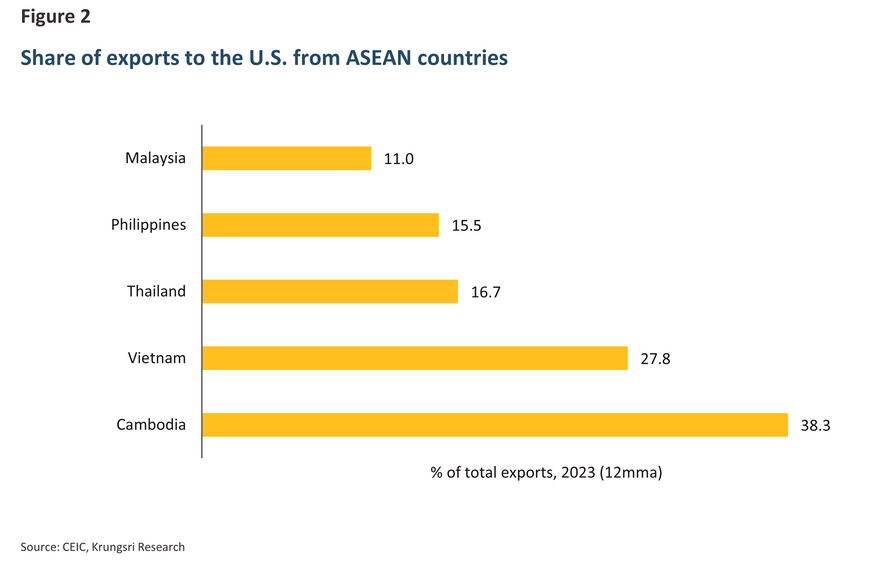
Other Significant Players
In addition to the U.S. and China, ASEAN also faces influence from other countries that affect the balance of power in the region. For example, Japan supports Official Development Assistance (ODA) and invests in infrastructure, such as high-speed rail in Indonesia and Vietnam, while also promoting security through Quad and its alliance with the U.S. to counterbalance China. Russia focuses on defense and energy cooperation, such as supplying weapons to Myanmar and exploring energy agreements, though its influence remains limited compared to the two superpowers, the U.S. and China.
Moreover, Taiwan is another significant player in ASEAN, especially in terms of the economy, as a source of Foreign Direct Investment (FDI) in Vietnam, particularly in manufacturing and technology5/. However, tensions between China and Taiwan could affect the supply chains in ASEAN, especially in semiconductors. Additionally, ASEAN's stance on the One China Policy will shape its future relations with Taiwan and its cooperation in the region.
Comparison of U.S. and China’s Influence in ASEAN
We can summarize the influence of the U.S. and China on various countries in the ASEAN region, in terms of both economic dimensions (considering FDI) and military and security aspects, as shown below (Table 1)
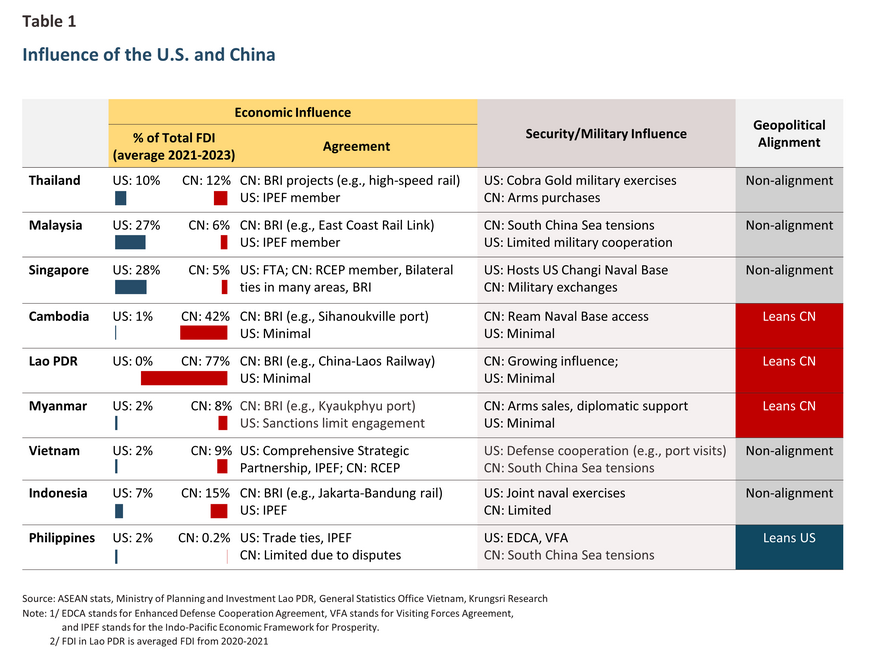
We can categorize the countries in ASEAN according to the influence of the U.S. and China into three main groups as follows:
1. China-Leaning Countries
-
Cambodia: is closely aligned with China, with China being the largest source of FDI. Additionally, China's permission to access the Ream Naval Base, a strategic military point, reflects China's influence on security matters in Cambodia.
-
Lao PDR: is another country that heavily relies on Chinese investment, compounded by significant borrowing from China. The BRI, such as the China-Laos Railway, has integrated Lao PDR into China's economic network, thereby increasing China's security influence in the country.
-
Myanmar: has a much closer relationship with China than with the U.S., through FDI and BRI projects such as the Kyaukphyu Port. China also provides military support to Myanmar's military government, while the U.S. has limited involvement due to sanctions.
2. US-Leaning Countries
-
The Philippines: has had a long-standing strong security relationship with the U.S., both economically and in terms of security (with the FDI from the U.S. being significantly higher than that from China). Currently, the Philippines maintains relations with the U.S. through military agreements aimed at countering China's influence in the South China Sea.
3. Non-alignment Countries
-
Singapore: strives to maintain a balance between the U.S. and China. It has built strategic cooperation with the U.S. and receives more FDI from the U.S., but it also has strong economic and social ties with China. This is reflected in China being Singapore's top trading partner, as well as the similarities in their demographics and culture.
-
Indonesia: seeks to balance its relations with the U.S. and China. While it receives more FDI from China and participates in BRI projects such as the Jakarta-Bandung High-Speed Railway, it also engages in military exercises with the U.S.
-
Vietnam: employs a "Bamboo Diplomacy" approach6/. While it currently relies on China for supply chains and investments, it has upgraded its relationship with the U.S. to a Comprehensive Economic Partnership to reduce dependence on China
-
Thailand: works to maintain a balance between the U.S. and China. Despite receiving more investment from China and purchasing weapons from China, Thailand maintains a military relationship with the U.S. through joint exercises such as Cobra Gold7/.
-
Malaysia: tries to maintain neutrality. Although it receives more FDI from the U.S. and is promoted in cooperation on innovation and technology by the U.S., it also has ties with China through its participation in the BRI, including projects like the East Coast Rail Link.
The power dynamics from the geopolitical perspective of various players, which impact countries in ASEAN, can be summarized in Figure 3.
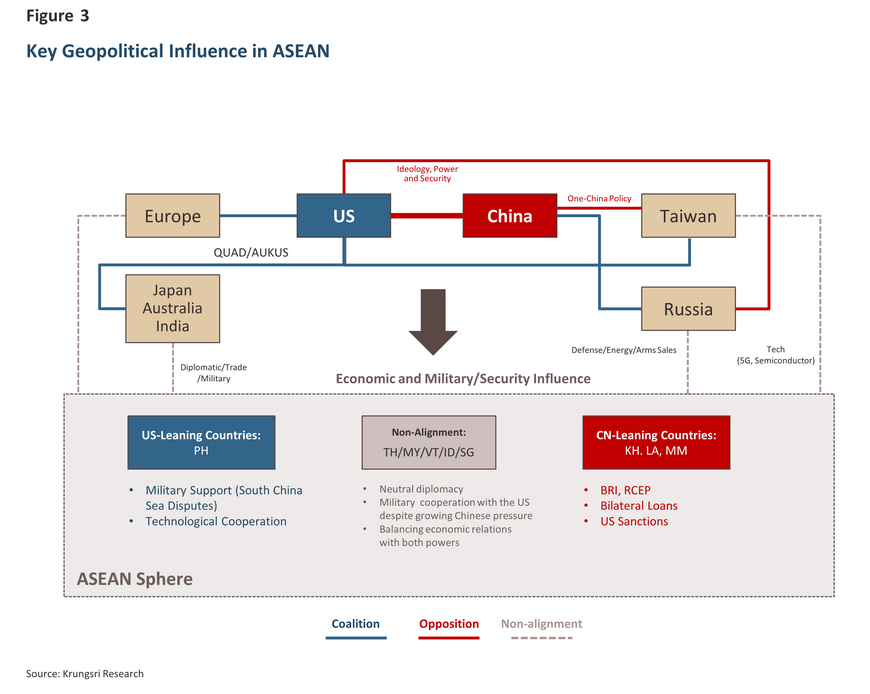
The assessment of the stances of the countries mentioned above largely aligns with the findings from foreign research agencies such as Capital Economics (Figure 4)8/, except for Vietnam's stance, which Capital Economics views as leaning towards the U.S. This may be due to the increased emphasis on political factors, particularly the strategic and diplomatic relationship between Vietnam and the U.S., which has developed significantly over the past decade, such as the elevation to a Comprehensive Strategic Partnership.
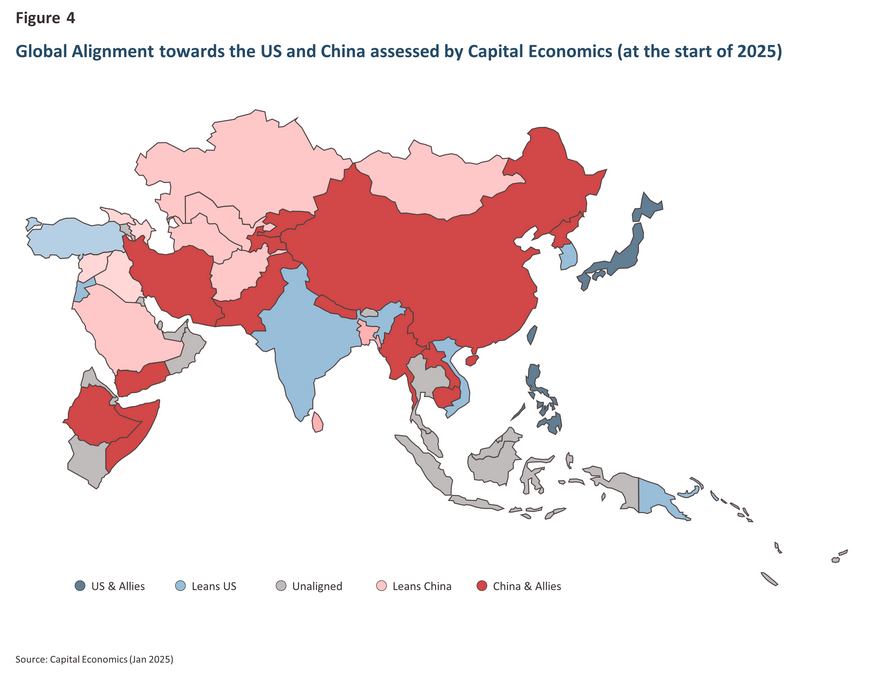
Key Geopolitical Challenges and Economic Implications
Currently, a prominent geopolitical conflict is the trade and technology competition between the U.S. and China, which impacts both the economy and security of the region.
The trade conflict between the U.S. and China officially began in 2018 during Donald Trump's first term as President and escalated during his second term (Trump 2.0). This reflects an attempt to reorganize the global order through economic nationalism and trade protectionism, with the goal of reducing China's influence in the global economy and preventing the rerouting of Chinese goods. Recently, a new round of import tariffs, effective from midnight on April 9, 2025, marked a significant escalation in the conflict, affecting China and other countries, including those in ASEAN. This creates complexity across trade, technology, and geopolitical dimensions.9/
The positions of various countries towards the latest customs tariff measures reflect an adaptation to a new context that differs from Trump's earlier period (2018-2020), which primarily focused on pressuring China. The current measures have broader impacts, affecting allies and other trading partners as well, leading to the following observations from a geopolitical perspective:
-
Most ASEAN countries are attempting to maintain neutrality between the U.S. and China. However, the latest U.S. import tariff hikes may force some countries to clearly choose sides, particularly Vietnam and Cambodia, which are accelerating negotiations with the U.S. to propose tariff reduction agreements and increase imports of various U.S. goods. This contradicts the earlier expectation that ASEAN would maintain a non-aligned stance.
-
China may seize this opportunity to expand its influence in ASEAN by offering economic aid and investment, while the U.S. could lose credibility in the region if its trade barriers negatively affect its economic allies.
-
At the same time, China's restrictions on the export of rare earth minerals10/ could escalate the conflict from a trade issue to a full-blown technology war, which may push ASEAN countries into a more explicit alignment.
Economic Impact
In the short term, U.S. import tariff hikes cause volatility in global trade and financial markets, with export-dependent countries like Thailand, Vietnam, and Cambodia facing the heaviest impacts. Additionally, a decline in China’s exports to the U.S. may lead to an influx of cheap goods into ASEAN (dumping), potentially harming domestic producers. Meanwhile, ASEAN countries that benefited from production shifts from China may face U.S. pressure to tighten scrutiny on goods originating from China, with the U.S. possibly enforcing stricter Rules of Origin checks if rerouting of Chinese goods is suspected.
In the long term, if the trade conflict intensifies and negotiations fail, ASEAN may lose its appeal as a key manufacturing base for global goods. Additionally, some countries in the region's clear alignment with the U.S. could trigger economic retaliation from China, particularly in the form of reduced or withdrawn investments, further exacerbating the vulnerability of ASEAN economies.
Security and Military Impact
Being forced to choose sides could significantly impact regional security, as under Trump 2.0, the U.S. may seek to expand its military and security influence in ASEAN through exchanges it desires, such as establishing military bases or increasing patrols in the South China Sea, in return for tariff reductions or favorable trade agreements. However, if these exchanges come to fruition, they could escalate tensions in the region and undermine the non-alignment foreign policies that many ASEAN countries have long tried to maintain.
Krungsri Research View
Analysis of the geopolitical dynamics in the ASEAN region reveals that ASEAN is not only a key global economic connector but also a strategic point where both the U.S. and China seek to expand their influence across various dimensions, including the economy, security, and technology. Overall, ASEAN countries exhibit a range of stances and levels of engagement with both superpowers. Some countries clearly align with one side, while others strive to maintain a strategic balance between the U.S. and China to ensure both economic and political stability.
The new trade policy under Trump 2.0, particularly the increase in import tariffs, has brought significant challenges and highlighted the "New World Order" that the U.S. seeks to push forward. This policy not only reshapes global trade regulations but also signifies a new power divide that ASEAN cannot avoid, potentially undermining the concept of "regionalization" and the unity of ASEAN. However, due to ASEAN's crucial role in the global economic supply chain, maintaining a flexible foreign policy is key to determining the future of its member states.
To address these challenges, ASEAN needs to adopt a hedging strategy by diversifying its relationships and building partnerships with other players beyond the U.S. and China, such as Japan, India, the European Union, and Australia. The trade agreements with the EU, for instance, present opportunities for ASEAN to enhance trade, investment, economic connectivity, and technology transfer. At the same time, regional cooperation is a critical mechanism for strengthening ASEAN, such as the Regional Comprehensive Economic Partnership (RCEP), the world's largest trade framework, and the ASEAN Digital Economy Framework Agreement (DEFA), which accelerates the transition to a digital economy and promotes innovation and technology competitiveness in the long run. In addition, ASEAN should prioritize fostering internal unity to bolster its bargaining power on the global stage. This can be achieved through concreate cooperation, such as leveraging the strengths of member states to build robust regional supply chains, thereby enhancing ASEAN’s competitive edge.
In conclusion, building a diverse network of alliances, promoting regional cooperation, and advancing ASEAN’s unity through concrete measures will enable the region to navigate geopolitical uncertainties. These efforts will also position ASEAN to transform challenges and risks into future economic opportunities.
References
Books:
Zeihan, P. (2022). The end of the world is just the beginning: Mapping the collapse of globalization. Harper Business.
ปิติ แสงศรีนาม, & จักรี ไชยพินิจ. (2566). สมรภูมิพลิกอำนาจโลก: Amidst the geo-political conflicts. กรุงเทพฯ: สำนักพิมพ์มติชน.
Articles and Reports:
Cosar, K., & Thomas, B. (2021). The geopolitics of international trade in Southeast Asia. National Bureau of Economic Research (NBER). Retrieved from https://www.nber.org/papers/w28048
Center for Strategic and International Studies (CSIS). (2023). Assessing U.S. and Chinese influence in Southeast Asia. Retrieved from https://www.csis.org/analysis/assessing-us-and-chinese-influence-southeast-asia
Capital Economics. (2025, January 7). Trump and the implications for global fracturing. Global Economic Focus.
ISC Special Talk. (2024, August). Global geopolitical developments: Implications for ASEAN. Seminar Report. Retrieved from https://www.csis.org/analysis/assessing-us-and-chinese-influence-southeast-asia
ISEAS – Yusof Ishak Institute. (2024, October). The curious case of sluggish US economic influence perceptions in ASEAN (Issue: 2024 No. 81). Retrieved from https://www.iseas.edu.sg/articles-commentaries/iseas-perspective/2024-81-the-curious-case-of-sluggish-us-economic-influence-perceptions-in-asean-by-kristina-fong/
Seah, S., et al. (2024). The state of Southeast Asia: 2024 survey report. Singapore: ISEAS – Yusof Ishak Institute. Retrieved from https://www.iseas.edu.sg/centres/asean-studies-centre/state-of-southeast-asia-survey/the-state-of-southeast-asia-2024-survey-report/
1/ Read more: On the Edge of Stability: Lao PDR and Cambodia’s Different Paths and ASEAN Implications
2/ The Philippines filed a case against China at the Permanent Court of Arbitration (PCA), which ruled in 2016 that China had no legal rights under international law. However, China rejected the ruling and continued to build military structures on artificial islands. Besides the Philippines, Vietnam has also faced conflicts with China over oil drilling in disputed waters.
3/ This includes the Changi Naval Base in Singapore, which is a strategic point supporting the U.S. 7th Fleet, and the U.S. bases in Subic Bay and Clark Air Base in the Philippines, which have been reactivated for maritime patrols.
4/ The Quadrilateral Security Dialogue (Quad) is a partnership between the U.S., Japan, India, and Australia, aimed at maintaining international order, maritime security, and addressing regional challenges. AUKUS is a trilateral security agreement between the U.S., Australia, and the United Kingdom, with a clear objective to enhance military capabilities in response to challenges in the Indo-Pacific, particularly addressing China's military expansion. AUKUS is a more explicit military alliance compared to Quad.
5/ For example, factories producing electronic components by Foxconn and Pegatron.
6/ The implementation of a flexible diplomatic policy that can adjust its stance to align with international situations or external pressures.
7/ The Cobra Gold exercise is the largest annual military training in Southeast Asia, organized by Thailand and the U.S. along with allied countries such as Japan, South Korea, and Singapore. It aims to strengthen security cooperation, conduct joint operations, and respond to disasters. This exercise began in 1982.
8/ Capital Economics evaluates the stances of countries based on three main criteria. First, economic factors include trade with the U.S. compared to China, investment from both sides, and financial aid. Second, political factors assess public opinion towards the U.S. and China, voting patterns in the UN, relations with Taiwan, and participation in initiatives like the BRI. Finally, security factors focus on military alliances, territorial disputes, and specific regional considerations, such as surveys conducted within the region. These criteria provide a comprehensive framework for understanding the geopolitical alignments of countries.
9/ However, President Trump announced a suspension of retaliatory tariff hikes with several countries for 90 days, starting from April 10, 2025, with the exception of China, where retaliatory tariffs continue to be applied between the two countries.
10/ This is used in advanced technology industries such as computer chips, electric vehicle batteries, and weapons. Currently, China holds a 70% share of global production (according to the US Geological Survey), giving it significant leverage in this area. Over the past two years, China has used the policy of controlling the export of critical minerals, such as gallium, germanium, graphite, and antimony, as a geopolitical tool in response to the U.S. amid the trade war.
11/ For example, leveraging Vietnam and Malaysia's manufacturing expertise along with Singapore's technological capabilities and Thailand's logistics system.










